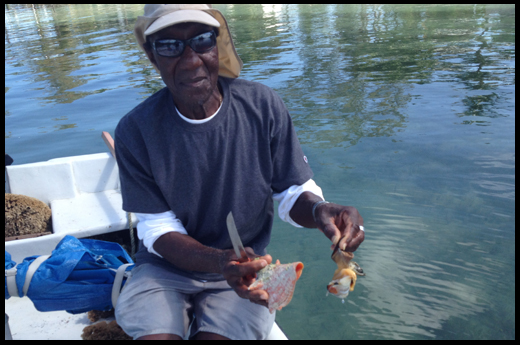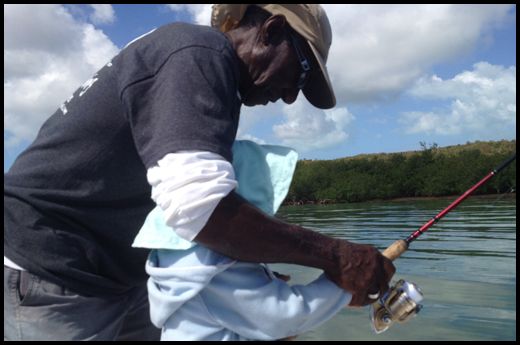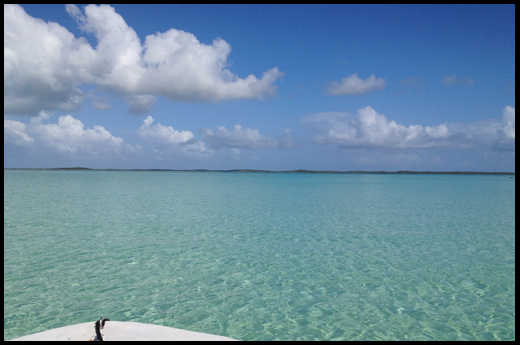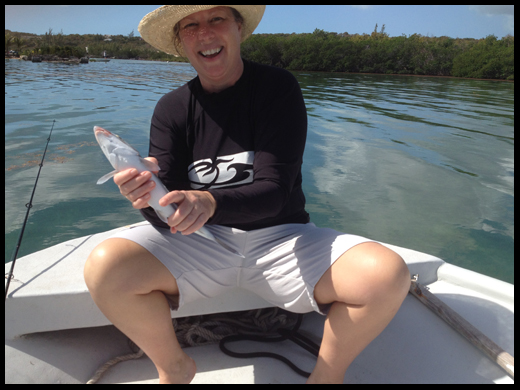Ever since I read an article in Garden and Gun about a bonefishing trip that Yvon Chouinard and Tom Brokaw took, I was curious about the sport. Mostly because it takes place in my favorite place of all, the shallow, crystal-clear turquoise waters of the Caribbean. Then, a coworker told me about his dad’s experience doing it and that it was “really hard,” and I got “hooked” on the idea. I had to try it. Plus, it is fun to say “bonefishing.”
So on a recent spring break family trip to Harbour Island, Bahamas, I stopped in at the tourist office and picked up the card of a local guide and a brochure on how to bonefish environmentally correctly. Bonefish are slightly endangered, so it’s strictly a catch-and-release sport. What I learned from Vincent, the guide who took us out, was that you wouldn’t even want to eat a bonefish because…they have too many bones! Dangerous bones, is what I think he said.
And thus, my 5-year-old and I set out on a bright sunny Saturday morning for a few hours of fishing. I decided to take Lucia for two reasons: 1) the mile-wide smile on her face as we sped across the “harbour” on a little boat from Eleuthera made me realize she’s a boat-lover like I am (thankfully, she knows how to swim well in case she falls out). And 2) she likes to fish. For her 4th birthday, at her request, we went trout-fishing.
Here are the basics:
- You start out in a tiny little boat (because for the fishing part, the boat is propelled by a pole) and go out in search of a conch for bait. Conch hang out in shallow, grassy waters pink side up. Vincent pulled a small one out with a kind of fork thing on a pole.

- Then you go around looking for signs of bonefish—usually holes in the sand where they dig for crabs or clouds of sand where they have just been digging. Fortunately, this happens to take you to amazingly beautiful deserted little coves that are perfect for a quick dip!

- Bonefishing can be done like fly-fishing (the challenging sort) or with a rod and reel (the kind for beginners). So we went to another cove to practice casting, where I proceeded to catch a bonefish…without bait!!!! Vincent was quite surprised.
- He cut up the conch for bait anyway (and he took the prime part, “scorched it,” dipped it in the sea, and ate it raw!)
- Then we did a bit more fishing, and I let Lucia try her hand at it. She was good at casting but didn’t catch anything. But by then it was getting hot and almost lunchtime, so we went back to the island with sunny grins on our faces.
So, will I become an avowed Bonefisher woman? No. I realized that what I really want to do is poke around in a small boat and just look at stuff and swim and enjoy the incredible water without having to catch something.
However, I also realized how important days like this are for little ones. Since my father passed away a long time ago and her other grandfather is 90 and barely able to get out of the house, the opportunity for her to have a surrogate grandfather like Vincent for a morning, and to be shown gently how to cast a rod and “jig it” (jigging is where you lightly pop the rod as you reel it in because you want the “fly” or the bait to look, in this case, like a crab hopping along the floor of the sea) is priceless.

I confess it took me four days to get up the courage to call a stranger to take me bonefishing. But I was determined when I turned 50 that it was number one (for no special reason) on my list of things to try in my “next 50 years.” And like so many things, the fear I had about doing it was just an indicator that I was about to do something totally cool and awesome. And the exhilaration of actually having accomplished it and enjoyed it was 10 times greater than the fear. I’m just saying.






Cool! Whenever, or if ever I get back to the Carribean, I’ll remember to try bonefishing!